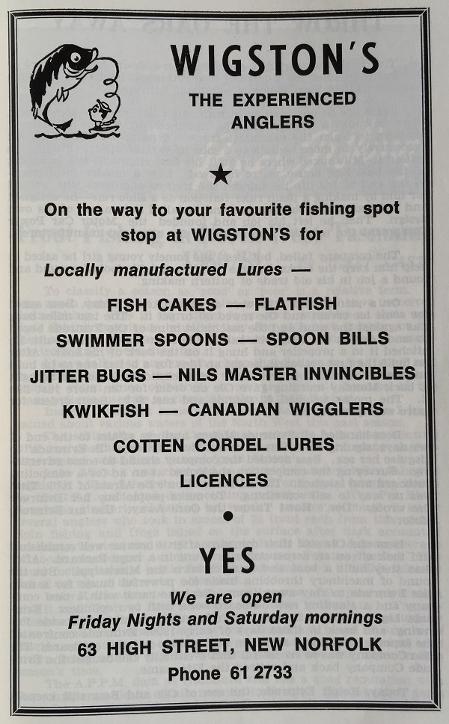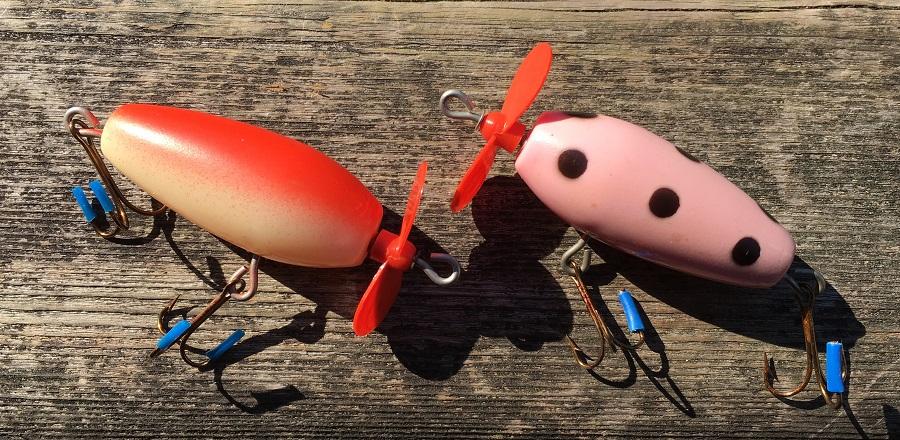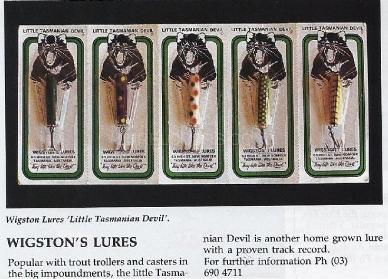Wigstons Lures - TAS:
*Banner Image - Very rare Wigstons display showing some of the earliest colour patterns
Wigstons is an historic Tasmanian company and you will find the history at the end of this page. Wigstons is the manufacturer of the now world famous Tassie Devil Lures but also of the now discontinued 'Devil Cake'. Wigstons had a shop in New Norfolk until 2013 which closed down after many years, The factory still manufactures Tasmanian Devil lures from Tasmania with a worldwide market aimed at mainly trout anglers.
"In 1934, Eddie Wigston founded a retail store in the town of New Norfolk situated on the Derwent River (a popular trout fishing district) 22 miles upstream from Hobart, the Capital of Tasmania. As a keen marksman and an avid fisherman he operated the business known as E.L. Wigston selling radios, firearms and fishing equipment until he was joined by sons Ian and Garth. The Wigston family are keen anglers and during the 1960’s considerable time was spent experimenting with home made fishing lures. Over the convivial glass of beer at the local club one Friday evening during the late 70’s, the concept of mass production of lures was discussed at length by Eddie, Ian and Garth." https://www.wigstonslures.com.au/about-us/
Wigston is an historic family name in Tasmania and the Wigston's shop was originally located at 63 High St, New Norfolk which is the main shopping strip in the town. The advertisement shown left is from a 1981 Tasmanian publication. The predominance of imported lures is obvious in but Wigston's always had locally made produce as well as starting to produce its own range.







Possibly Wigstons rarer lure is the 'Devil Cake' which was a version of surface lure to compete in the very popular Tasmanian 'fish cake' market.

The Wigston's 'Tassie Devil' emerged onto the market by 1980 and was well advertised in Tasmanian publications like the Tasmanian Angling Reports which were released each year.
The head of the native Tasmanian Devil has been the logo from the start. Opposite is an extremely rare Wigstons Tasmanian Devil cloth patch which only ever made in small numbers. It is an iconic Tasmanian native animal and the logo has stood the test of time and Wigstons Tasmanian Devil lures have a worldwide market with many patterns only made for the export market.
Dates of the advertising below are from 1991 with the introduction of the 7g 'Little Devil' to 1992 with the 26g 'Big Devil' added to the range, the photofinish range was available by 1993 with up to 58 colours in 1994.





"In 1934, Eddie Wigston founded a retail store in the town of New Norfolk situated on the Derwent River (a popular trout fishing district) 22 miles upstream from Hobart, the Capital of Tasmania. As a keen marksman and an avid fisherman he operated the business known as E.L. Wigston selling radios, firearms and fishing equipment until he was joined by sons Ian and Garth. The Wigston family are keen anglers and during the 1960’s considerable time was spent experimenting with home made fishing lures. Over the convivial glass of beer at the local club one Friday evening during the late 70’s, the concept of mass production of lures was discussed at length by Eddie, Ian and Garth."
The lure shown opposite is an early 4X pattern in an early packet. Simple cardboard header stapled to a plastic bag. Wigston's printed on one side with reverse plain with no writing.


Note lure has the black ends and would most probably have been hand painted. Also the base coat is a light gold with four crosses and five dots.

Possibly the rarest Tassie Devil could be the elusive No 2 colour shown missing from an early salesmans sample box and not listed as a catalogued colour in later catalogues. Unsure of the history around this however the colour charts always seem to skip from colour 1 to colour 3.
The lure shown opposite came up for sale via Ebay and fetched an extremely high price for a Wigstons Tasmanian Devil. It is however on an early card and the rare blue with black spot pattern.


The 'Tassie Devil' has emerged as a collectable lure in its own right and gained popularity in the last few years with collectors aiming to complete full colour sets especially the earlier patterns. With new colour variations and patterns being released every year the Tasmanian Devil collectors of the future will be looking at hundreds of lures to complete sets.


The earliest Wigstons 'Tasmanian Devil' perferated cards will be numbered with colour pattern and High St address in New Norfolk. The rarer colours are fetching high prices in the modern market.
Below are some uncommon early colours


Wigstons catalogues are now collectable but will also show you older colour patterns, deleted colour codes and newer patterns as they were introduced to the market.


Wigstons Tasmanian Devil range catalogue for 1990 including smaller 7 gram range


Wigstons Tasmanaian Devil range at Harbord Tackle catalogue for 1990

Wigstons Tasmanian Devil range also included a small range of trout spoons that are now very rare and hard to find especially on the original New Norfolk cards.
They are shown opposite and came in at least two sizes in both a rainbow and brown trout pattern




Above is the introduction of the small Tassie Devil c.1991.
Below is shown the introduction of the realistic trout finish patterns.

Left is shown a salesman ring sample of some later colour patterns and variations.
Below is a set of Tasmanian Devils that was offerred for sale on Gum Tree in 2015.
The following tribute was published in the Tasmanian Angling Report 1990 and gives some of the history of the Wigston family business which stayed in the Wigston family in New Norfolk until the business closed in High Street in 2013.

Extract from Fishing Monthly - There are many Tasmanian fishing icons, but none have captured the world like Wigston’s Tasmanian Devil lures.
''Wigston’s Lures make the world famous Tasmanian Devil lures which have been catching prodigious amounts of fish the world over since 1979. It might come as a surprise to learn that this Tasmanian company is perhaps the largest Australian lure manufacturer, and while Wigston’s Lures supremo Garth Wigston is reluctant to publically say just how many lures they manufacture each year, you can take it from me that it is a mind-boggling amount. Considering that 80% of their production heads overseas and that the Tasmanian Devil is without doubt the most popular freshwater lure in Australia, you can soon appreciate the staggering amount of these simple yet effective lures that hit the shelves every year.
The history of the Wigston business
While anglers associate the Wigston name with fishing, the family, under the leadership of Eddie Wigston, first started business in manufacturing of a different sort. Established in New Norfolk in the 1930s, Wigston’s made radios and also charged the batteries for these units. From there they expanded into retailing over the years, selling all whitegoods, televisions and so on into the colour television days. Wigston’s even had the first video rental store in New Norfolk. Around this time Garth Wigston returned to the family business and began thinking about new business opportunities. Ian Wigston was handmaking lures under his house, which were starting to become very popular with Tasmanian anglers. The idea was raised with Eddie to mass-produce these lures, which initially wasn’t met with much acceptance! However Garth and Ian persevered and after adapting an old woodshed behind the shop in New Norfolk, the first commercially produced Tassie Devils hit the water. With the assistance of the Department of Industrial Design in Hobart in sourcing plastics to suit the process, and moving on from the original clothes peg clamped manufacturing process, the Tassie Devil lure began to get the economy of scale which would see it grow into what it is today.
The origins of the lure
Garth Wigston has done a lot of personal research into the origins of the cobra style lure. As far as he is able to ascertain, and he is pretty much 100% sure of this, Brian Johnson first came up with the concept of this lure in the 1950s. As a Chinese philosopher once said, “success has a thousand fathers”, and many others lay claim to inventing it, but Garth is adamant that Brian Johnson deserves the credit. As far as the name goes, that was one of those seminal moments around the campfire when the question of what to name then came up. John Heizer simply said, “Why don’t you just call them the Tassie Devil?” The name stuck and now the Tasmanian Devil is seen all round the world as an extremely simple and effective lure.
The key to success
Garth puts the success of the lure down to several important issues. The main one is the action and the fact each lure will swim exactly the same – the manufacturing process Wigston’s use means that each and every lure released from the factory has precisely the same swimming action. This means that anglers can tie on a Tassie Devil and with 100% confidence will know that it will swim properly, straight from the packet. The action mimics a wounded baitfish – the lure ducks, darts and pauses, even while trolling. This action is irresistible to trout, and combined with a massive range of colours it is easy to see why they have been so popular.
The second is a choice of colours that suits anglers’ needs. With over 100 colours in the range and four different sizes to choose from, these lures have all species and all waters catered for.
The third one is price, these lures are cheap – every angler, irrespective of whether it is a kid saving up their pocket money or the battling family angler can always have half a dozen Tasmanian Devils in their tackle box. At the price these lures retail for, anglers never have to worry about losing a lure to snags.
The manufacturing process
This is very much a hands-on process combined with state of the art injection moulding technology. Wigston’s have spent decades refining their process – engaging some very clever tool making and mechanical processes to make creating these lures as efficient as possible while still retaining that handmade quality. Some of the tooling that Wigston’s use was said to be impossible to make, but they made it! Understandably Garth is very reticent to publically reveal how exactly these lures are made – suffice to say there is a mountain of Tasmanian ingenuity inside that factory.
A proudly Tasmanian Company
Wigtson’s are a proud Tasmanian company producing a unique product on the banks of the Derwent River in Hobart. While many others have headed overseas in search of cheap manufacturing and cheap labour, Wigston’s have steadfastly stood by their proud Tasmanian roots, proving that businesses can be successful exporters in Tasmania. In the manufacturing process, Wigston’s use as much local content as possible; it’s either made in Tasmania or sourced from Tasmanian agents. The best plastic for making the lures is sourced from Italy, while the very important hooks are from VMC, who have been able to provide the quantities and quality of hooks to Wigston’s for more than 27 years. Wigston’s is also extremely conscious of their environmental responsibilities. The factory recycles all waste products such as plastic used in the injection moulding process, waste packaging is sent for recycling – even the wash used to clean the spray guns is sent back to be filtered, cleaned and re-used. The staff at Wigston’s are also at the heart of the business, with some team members having well over 20 years of service, including manager Justin Causby, who is a more than capable angler for many different species.
What’s in a name
While to many Tasmanians the brand name Tasmanian Devil might not seem so huge, a few international companies have tried on occasions to assert trademark rights over the name. Being an international product, Tasmanian Devil lures came under the scrutiny of Warner Bros, the massive USA media and movie company. Claiming international rights to the name Tasmanian Devil, it looked like the small Tasmanian company might have the fight of its life just to retain it’s brand. Common sense prevailed (and that doesn’t happen often), and the two companies agreed that Tasmanian Devil branded lures weren’t going to harm Warner Bros business nor trade off a cartoon character. Wigston’s faced yet another trademark battle several years later, again in the USA. A company there launched legal action in the USA court system over the rights to the Tasmanian Devil lure brand, and after a very expensive fight, the claimant simply ran out of money and the case was dropped.
Community Support
Wigston’s are a very generous company that supports Tasmanian fishing in many ways; the most noticeable is the amount of fishing competitions sponsored by Wigston’s. Competitions supported by Wigston’s are too numerous to list, but there wouldn’t be a trout based competition in Tasmania that wouldn’t have some Wigston’s product as prizes.
The most popular lure
With so many lures on the market for so long, I just had to ask Garth and Justin just what the most popular lure was. I was thinking like a trout angler that colours 50 or 51 would come out tops, but the most popular selling lure colour are the pink ones! I guess when you think about it, the most important thing in the whole deal is getting fish to take notice of the lure, and what more striking colour than pink! And it catches a whole lot of fish too. It is often said that the best flattery is imitation. There are so many different imitations/copies of the original cobra, all of which just trying to capture a small percentage of the success that Wigston’s Tasmanian Devils have. Like the Tasmanian devil, these lures are 100% Tasmanian. Born and bred on Tasmania’s world-class trout fishery, these simple yet effective lures have captured the global fishing scene like no other, catching a diverse range of fresh and saltwater species. And just like the Tasmanian devil, this company is a unique symbol of everything great about Tasmania.
